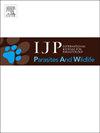东方鹳保护的重要病原体棘孔虫(Chaunocephalus ferox)的全线粒体基因组及其系统发育意义
IF 2.2
3区 医学
Q3 ECOLOGY
International Journal for Parasitology-Parasites and Wildlife
Pub Date : 2025-08-23
DOI:10.1016/j.ijppaw.2025.101129
引用次数: 0
摘要
白鹳(Chaunocephalus ferox)是一种感染鹳的肠道吸虫,越来越被认为是对东方鹳(Ciconia boyciana)保护的潜在威胁。然而,它的进化历史仍然知之甚少。在这项研究中,我们使用MITOS2和GeSeq平台组装并注释了C. ferox的第一个完整线粒体基因组。该环状基因组全长17482 bp,编码12个蛋白质编码基因,22个trna和2个rrna,有几个基因间重叠和缺乏atp8基因。采用极大似然和贝叶斯推理方法对57种吸虫的12个线粒体蛋白编码基因进行了系统发育分析。虽然形态特征支持其在棘孔虫科的分类,但线粒体系统发育却产生了不一致的位置,在不同的基因树中,C. ferox要么位于片形虫科附近,要么位于两个科之外。分化时间的估计进一步支持了这一模糊性,将C. ferox从其他棘口虫中分离出来的时间定为大约7500万至3900万年前,与棘口虫科和片形虫科的分化重叠,表明它可能代表了一个早期分支谱系。此外,从三个地区和两个宿主物种的样本中获得的cox1序列是相同的,表明采样点之间的线粒体差异很低。虽然有限的样本量排除了关于人口结构的确切结论,但这种模式可能暗示了最近的人口扩张或跨地理区域的共同祖先。本文章由计算机程序翻译,如有差异,请以英文原文为准。

Complete mitochondrial genome and phylogenetic implications of Chaunocephalus ferox (Digenea: Echinostomatidae), a critical pathogen for Oriental Stork conservation
Chaunocephalus ferox is an intestinal trematode infecting storks and is increasingly recognized as a potential threat to the conservation of the Oriental Stork (Ciconia boyciana). However, its evolutionary history remains poorly understood. In this study, we assembled and annotated the first complete mitochondrial genome of C. ferox using the MITOS2 and GeSeq platforms. The circular genome spans 17,482 bp and encodes 12 protein-coding genes, 22 tRNAs, and 2 rRNAs, with several intergenic overlaps and absence of the atp8 gene. Phylogenetic analyses based on 12 mitochondrial protein-coding genes from 57 trematode species were conducted using maximum likelihood and Bayesian inference methods. While morphological characteristics support its classification within Echinostomatidae, mitochondrial phylogenies yielded inconsistent placements, with C. ferox positioned either near Fasciolidae or outside both families in different gene trees. Divergence time estimation further supports this ambiguity, placing C. ferox's split from other echinostomatids at approximately 75–39 million years ago, a period overlapping with the divergence of Echinostomatidae and Fasciolidae, suggesting it may represent an early-branching lineage. Additionally, cox1 sequences obtained from samples across three regions and two host species were identical, indicating low mitochondrial variation across sampling sites. While the limited sample size precludes firm conclusions about population structure, this pattern may hint at a recent demographic expansion or shared ancestry across geographic areas.
求助全文
通过发布文献求助,成功后即可免费获取论文全文。
去求助
来源期刊

International Journal for Parasitology-Parasites and Wildlife
Medicine-Infectious Diseases
CiteScore
3.80
自引率
5.60%
发文量
113
审稿时长
45 days
期刊介绍:
The International Journal for Parasitology: Parasites and Wildlife (IJP-PAW) publishes the results of original research on parasites of all wildlife, invertebrate and vertebrate. This includes free-ranging, wild populations, as well as captive wildlife, semi-domesticated species (e.g. reindeer) and farmed populations of recently domesticated or wild-captured species (e.g. cultured fishes). Articles on all aspects of wildlife parasitology are welcomed including taxonomy, biodiversity and distribution, ecology and epidemiology, population biology and host-parasite relationships. The impact of parasites on the health and conservation of wildlife is seen as an important area covered by the journal especially the potential role of environmental factors, for example climate. Also important to the journal is ''one health'' and the nature of interactions between wildlife, people and domestic animals, including disease emergence and zoonoses.
 求助内容:
求助内容: 应助结果提醒方式:
应助结果提醒方式:


